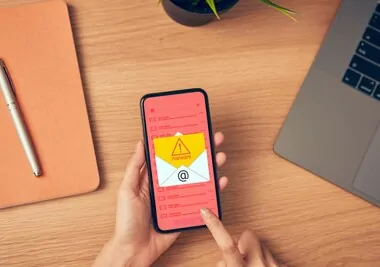
One click away from disaster: the importance of email security
As the main form of communication for businesses, emails are sent and received by most without so much as a second thought. Yet, according to our research, 48% of security professionals believe that their organisation would be more secure if they didn’t use email.
When COVID-19 hit and the era of remote working was accelerated, focus shifted to establishing email security measures for protecting remote workforces communicating and sharing data outside the protection of the controlled environment of the office network and to minimising the risks of shadow IT and supporting BYOD policies.
Yet, according to the 2021 Government Security Breaches Survey, phishing attacks remained the most common threat vector, with 83% of the attacks identified being related to phishing. This has risen by 11% over the past four years.
With 62% of businesses confirming that phishing attacks were the most disruptive vector, it is clear that email security should sit high up on the priority lists for organisations.
Email security does not have to be complicated, but it must be done right.
Identify and protect
Our research found that 86% of professionals agreed that email security threats have become more sophisticated over the past decade.
A harmful email can come in many different forms, with numerous intentions and are growing ever more sophisticated in their design and delivery. Threats can range from stealing credentials and other data, to sending a malicious file or link.
Email impersonation techniques, such as Business Email Compromise (BEC), or CEO Fraud, have been used to trick employees into handing over credentials, or opening a harmful document. It is a particularly cunning method as criminals know that individuals, particularly new and inexperienced employees are far more likely to hand over sensitive information or money if they believe the request has come from their employer.
Malicious emails often inflict harm via a link to a website, documents, or multiple redirects to the ultimate payload. One click could be all it takes to compromise an account, so an email should not be taken at face value.
There are a number of options available for businesses wishing to lock down their email security.
Linkscanning is becoming particularly important as a way of preventing the ‘one-click disaster.’ Through the option of scanning links at the time of delivery, account users are able to identify malicious links before damage can be inflicted.
This method goes beyond the first click to check down the whole rabbit hole for threats. Each attack varies in its level of complexity and intricacy, and so linkscanning helps bridge the gap of where some email security ‘ends’ and stop that ‘one click’ that makes all the difference.
Moving forwards with email security
Tellingly, 85% of security professionals thought their current email security solution was adequate or comprehensive. But it would have been impossible to evaluate the success of its security when faced with mass remote working, when a transition on this scale had never happened before.
It is vital that organisations continue to evaluate their email security effectiveness on a regular basis, in order to keep up with the dynamic threat landscape.
As criminal methods continue to evolve, so will the need for greater protection. Businesses should conduct an honest assessment of their email security solution and evaluate if it truly lives up to the standard of protection required.
If the current solution lacks the layers of algorithmic analysis, threat intelligence, executive monitoring and real-time link scanning needed to defend against advanced email threats, an upgrade will be required to give the necessary level of protection.
With solutions providing ‘time-of-click’ protection from malicious links in emails, employers and their workers can operate safely and confidently, whether together in the office or from any number of remote environments.
Email attacks can, and will happen frequently and it’s crucial to not allow one absent-minded click to threaten the foundations of your business and lead to costly downtime or reputational damaging data breaches.
Discover the ways in which you can boost your email security and help keep your sensitive data safe.
